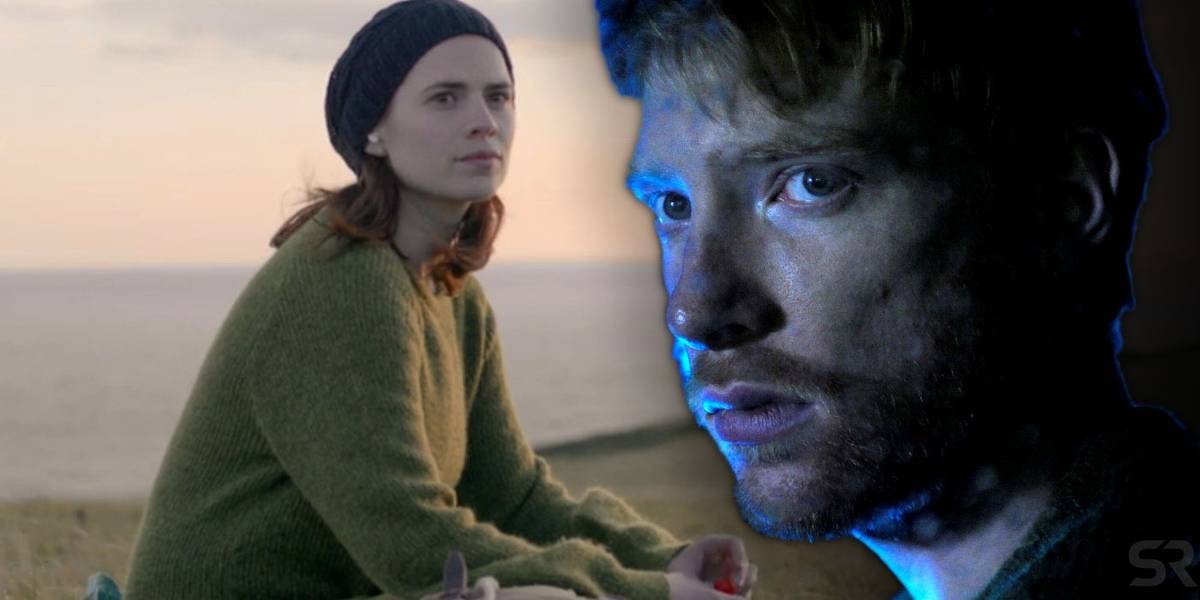Instead of giving the kind of hopeful closure that some viewers might expect, the ending of “Be Right Back” reflects the tone of the entire Black Mirror series, where sorrow and the influence of technology mix in subtle ways.
Charlie Brooker’s sci-fi anthology, Black Mirror, has gained recognition from critics and audiences for its deep take on modern-day issues and how advanced tech can shape people’s lives in ways that are both emotional and psychological.

Most episodes from Black Mirror usually build towards a sharp turn or twist near the end, often filled with dark satire, though there are a few that bring out slightly softer themes or more hopeful resolutions.
However, some episodes fall between both ends of this spectrum, presenting stories that, while sad, may still offer some form of emotional weight depending on how one looks at it. The season 2 premiere, “Be Right Back,” fits that middle ground.
“Be Right Back” Story Setup
The storyline centres around Martha (played by Hayley Atwell) and her boyfriend Ash Starmer (played by Domhnall Gleeson), who had just relocated to a quiet and isolated family house in the countryside that belonged to Ash’s family.
Sadly, Ash dies in a car crash the very next day. While trying to process his death, Martha discovers a technological service that lets her communicate with an AI version of Ash. This soon evolves into a physical android that closely resembles the real Ash, both in looks and mannerisms.
But just like most technologies within the Black Mirror series, this one comes with deep emotional consequences.
Martha’s Realization & The Episode’s Time Jump
Rather than immediately realising the problem with her decision, Martha continues living with android Ash for a few days while hiding him from others. Her sister Naomi eventually visits, and upon noticing men’s items in the house, assumes Martha has found a new man and moved on.
That visit forces Martha to reflect, realising that bringing android Ash into her life was not progress at all, but the opposite. Even though the android looks and speaks like the real Ash, deep down, she knows something vital is missing.
It reaches a breaking point when Martha tells him that if he’s going to pretend to sleep, then he should also pretend to breathe. She becomes uncomfortable lying beside a machine that lacks true human qualities.
When she tells him to leave, and he obeys without resistance, she gets angry because the real Ash would have argued with her. She tells him again to go and begins hitting him, shouting for him to fight back, something he cannot do due to a lack of emotional history or any trace of aggression.
Eventually, she orders him out of the house, and he obeys. The following morning, she sees him standing by the fence outside. He explains that he cannot go beyond a certain distance from his activation point—linked to the bathroom—unless Martha, who is his administrator, accompanies him.
She then takes him along for a hike, and they arrive at a cliff. Martha tells him to jump, and after some confusion, he gets ready to do it. She breaks down, saying the real Ash would never jump but instead would beg for his life and cry.
When android Ash finally mimics that behaviour, Martha reacts by saying it is unfair and lets out a scream before the screen fades to black. Right after that emotional peak, the story jumps ahead by some years. Martha still lives in the countryside with her daughter, and it’s the little girl’s birthday.
While serving cake, her daughter asks if she can take an extra slice to the attic. Martha hesitates at first, saying it isn’t the weekend, but agrees because it’s her daughter’s birthday. The child then walks up to the attic, where android Ash is kept.
She talks to him while Martha stands quietly at the bottom of the stairs. Her daughter then invites Martha to come up, and after pausing for a while, she accepts.
What Became Of Android Ash
After Martha accepted that android Ash could never mirror the depth and identity of the original Ash, she decided to isolate him in the attic, just as Ash had once said his mother did with memories of her late husband and another child.
That attic became a kind of storage place—not just for objects, but for memories and emotional remnants. Whether Martha moved android Ash there before or after her daughter was born isn’t made clear, but what is known is that the girl appears unaware that Ash is a copy of her father.
Only the child interacts with him now, and even that happens only on weekends. Though most people keep household attics for extra storage, many stories in literature and film suggest a deeper meaning behind them. Attics are often tied to secrets, especially the type one chooses not to confront.
At times, they are seen as metaphors for the human mind, where thoughts or memories are hidden until the person is ready to face them. For Martha, android Ash represents such a secret.
She never mentioned his existence to her sister, despite being close to her, and she has only allowed her daughter occasional access to him. This shows she’s still not ready to let go of her grief fully.
Martha’s Struggle With Grief
Grief takes centre stage in “Be Right Back.” People often process loss in their ways, but since this story is part of Black Mirror, it also considers how advanced technology shapes that process, and not always for the better.
Martha was initially against the concept of using AI to bring Ash back, feeling it was wrong for a machine to imitate someone using only online data. But when the sorrow became too much, she changed her mind.

Her reliance on this artificial Ash soon grew strong, as seen when she panicked after losing access to the AI due to a phone issue. At no point did Martha truly face the emotions tied to Ash’s death. Instead of dealing with it, she paid a high price for the synthetic body that housed android Ash.
Even when she acknowledged that the android could never store the real Ash’s memories, she still couldn’t let go. While it became clear that the real Ash was no more, Martha didn’t fully come to terms with it. If she had, she would have discarded android Ash altogether.
Her decision to keep him hidden away reflects how grief, if unresolved, can stretch on for years, regardless of whether someone appears to have moved on with life.
The Difference Between Online Images & Real Identity
The AI used in “Be Right Back” was programmed to copy every online trace of the deceased person to form a digital version of them. But because the data came from the internet, Android Ash ended up becoming only a mirror of Ash’s best side, not his full identity.
Martha even mentioned that android Ash looked like Ash on his best days, and the machine confirmed that most people only upload their most flattering images. People tend to curate what they post, presenting a cleaner, often exaggerated version of themselves.
These online profiles don’t fully reflect who someone is on the inside. Before their hike, android Ash commented on a framed picture of himself as a child, saying it was funny. At the beginning of the episode, he had uploaded that same photo online with a caption that it might amuse people, even though it had a painful backstory.
That interaction highlights the difference between what is shared publicly and what truly exists behind the scenes. No matter how honest someone appears to be online, it never paints the full picture. Martha’s journey is proof of this misunderstanding, though with time, she came to realise it.
The android was only a trial version of the AI system, yet it carried the same weighty consequences as many tech innovations aiming to play creator. It also brings to mind the idea behind Victor Frankenstein’s monster—a creature made in man’s image but never truly accepted as human.
Although android Ash was able to copy Ash’s tone and expressions, he could not feel or respond in genuinely human ways. This was obvious in how he showed no emotion or warmth when Martha’s daughter interacted with him. He recognised her as Ash’s child, but had no instinct to love or care for her.



